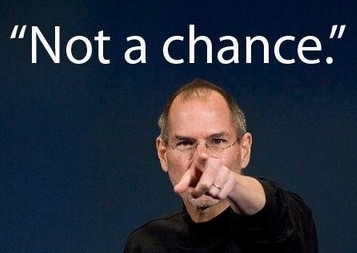The Launch, October 1988
1988年10月,NeXT發(fā)布會(huì)
Jobs had perfected the art of turning product launches into theatrical productions, and for the world premiere of the NeXT computer—on October 12, 1988, in San Francisco’s Symphony Hall—he wanted to outdo himself. He needed to blow away the doubters. In the weeks leading up to the event, he drove up to San Francisco almost every day to hole up in the Victorian house of Susan Kare, NeXT’s graphic designer, who had done the original fonts and icons for the Macintosh. She helped prepare each of the slides as Jobs fretted over everything from the wording to the right hue of green to serve as the background color. “I like that green,” he said proudly as they were doing a trial run in front of some staffers. “Great green, great green,” they all murmured in assent.
喬布斯將產(chǎn)品發(fā)布變成戲劇作品的藝術(shù)已經(jīng)登峰造極。NeXT電腦全球首發(fā)式定于1988年10月12日在舊金山交響樂堂舉行,喬布斯想要超越自己,他要澄清質(zhì)疑。在發(fā)布會(huì)前幾周,他幾乎每天都要開車去舊金山,藏身于蘇珊·卡雷的維多利亞風(fēng)格的房子里。蘇珊·卡雷是NeXT的圖形設(shè)計(jì)師,她為麥金塔設(shè)計(jì)了最初的字體和圖標(biāo)。由于喬布斯操心發(fā)布會(huì)的每一個(gè)細(xì)節(jié),從措辭到綠色背景的色調(diào),所以要由卡雷來幫忙準(zhǔn)備每一張幻燈片。“我喜歡這種綠。”他自豪地說,當(dāng)時(shí)他們正在一些工作人員的注視下進(jìn)行預(yù)演。“很棒的綠色,很棒的綠色。”眾人一致低聲說道。喬布斯精心制作、潤色并修改了每一頁幻燈片,就好像自己是T·S·艾略特,要將埃茲拉·龐德(EzraPound)的建議寫進(jìn)《荒原》(TheWasteLand)一樣。
No detail was too small. Jobs went over the invitation list and even the lunch menu (mineral water, croissants, cream cheese, bean sprouts). He picked out a video projection company and paid it $60,000 for help. And he hired the postmodernist theater producer George Coates to stage the show. Coates and Jobs decided, not surprisingly, on an austere and radically simple stage look. The unveiling of the black perfect cube would occur on a starkly minimalist stage setting with a black background, a table covered by a black cloth, a black veil draped over the computer, and a simple vase of flowers. Because neither the hardware nor the operating system was actually ready, Jobs was urged to do a simulation. But he refused. Knowing it would be like walking a tightrope without a net, he decided to do the demonstration live.
所有細(xì)節(jié)都很重要。喬布斯親自核查了邀請(qǐng)名單,甚至還有午餐菜單(礦泉水、牛角面包、奶油乳酪、豆芽)。他挑選了一家視頻投影公司,并支付了6萬美元聘用他們負(fù)責(zé)視聽支持。他還聘請(qǐng)了后現(xiàn)代主義戲劇制作人喬治·科茨(GeorgeCoates)籌劃這次發(fā)布會(huì)。不出所料,科茨和喬布斯決定采用莊重而極為簡單的舞臺(tái)外觀。一個(gè)極簡主義的舞臺(tái),背景是黑色的,桌子上罩著一塊黑布,黑色遮布披在電腦上,旁邊擺著一瓶簡單的花,完美的黑色立方體將在這種布置中掲曉。由于硬件和操作系統(tǒng)都沒有真正完成,有人提議用模擬展示。但喬布斯拒絕了。他決定現(xiàn)場示范,盡管他知道,這會(huì)像走鋼絲而沒有安全網(wǎng)一樣。
More than three thousand people showed up at the event, lining up two hours before curtain time. They were not disappointed, at least by the show. Jobs was onstage for three hours, and he again proved to be, in the words of Andrew Pollack of the New York Times, “the Andrew Lloyd Webber of product introductions, a master of stage flair and special effects.” Wes Smith of the Chicago Tribune said the launch was “to product demonstrations what Vatican II was to church meetings.”
3000多人來到了現(xiàn)場,他們?cè)诎l(fā)布會(huì)開始前兩小時(shí)排隊(duì)進(jìn)入交響樂堂。他們沒有失望,至少這次展示表演沒有令他們失望。喬布斯在臺(tái)上待了3個(gè)小時(shí),他再一次成為《紐約時(shí)報(bào)》記者安德魯·波拉克口中的“產(chǎn)品發(fā)布界的安德魯·勞埃德·韋伯(AndrewLloydWebber)①,舞臺(tái)風(fēng)格和特效大師”。《芝加哥論壇報(bào)》(ChicagoTribune)的韋斯·史密斯(WesSmith)稱,NeXT的發(fā)布會(huì)“之于產(chǎn)品演示,就像梵蒂岡第二屆大公會(huì)(VaticanII)之于教會(huì)聚會(huì)一樣”
Jobs had the audience cheering from his opening line: “It’s great to be back.” He began by recounting the history of personal computer architecture, and he promised that they would now witness an event “that occurs only once or twice in a decade—a time when a new architecture is rolled out that is going to change the face of computing.” The NeXT software and hardware were designed, he said, after three years of consulting with universities across the country. “What we realized was that higher ed wants a personal mainframe.”
“很髙興能回來。”喬布斯以他一貫的開場白引發(fā)了觀眾的歡呼。他開始述說個(gè)人電腦架構(gòu)的歷史,并向現(xiàn)場觀眾承諾,他們即將見證一個(gè)“10年中才會(huì)發(fā)生一次或兩次的歷史性事件——一個(gè)新的架構(gòu)即將推出,并將改變計(jì)算機(jī)的面貌”。喬布斯說,在經(jīng)過3年對(duì)全國高校的咨詢后,公司設(shè)計(jì)出了NeXT軟件和硬件。“我們意識(shí)到,高等教育行業(yè)的人需要的是個(gè)人大型主機(jī)。”
As usual there were superlatives. The product was “incredible,” he said, “the best thing we could have imagined.” He praised the beauty of even the parts unseen. Balancing on his fingertips the foot-square circuit board that would be nestled in the foot-cube box, he enthused, “I hope you get a chance to look at this a little later. It’s the most beautiful printed circuit board I’ve ever seen in my life.” He then showed how the computer could play speeches—he featured King’s “I Have a Dream” and Kennedy’s “Ask Not”—and send email with audio attachments. He leaned into the microphone on the computer to record one of his own. “Hi, this is Steve, sending a message on a pretty historic day.” Then he asked those in the audience to add “a round of applause” to the message, and they did.
同以往一樣,他的演講有些溢美之詞。喬布斯說,該產(chǎn)品“令人難以置信”,是“我們所能想象的最好產(chǎn)品”。他甚至稱贊機(jī)器內(nèi)部看不到的部件也工藝完美。他用手指托著一個(gè)1平方英尺見方的電路板,這個(gè)電路板將放在NeXT1英尺見方的機(jī)箱中。他熱情地說道:“我希望你們一會(huì)兒能有機(jī)會(huì)看看這個(gè)東西。這是我一生中見過的最漂亮的印刷電路板。”喬布斯接著展示了這臺(tái)電腦播放講話的功能,他播放了馬丁·路德·金的《我有一個(gè)夢想》和肯尼迪的《不要問》(AskNot),以及發(fā)送加載音頻附件的郵件的功能。他俯下身,對(duì)著電腦的麥克風(fēng),錄下了自己的聲音。“嗨,我是史蒂夫,在這個(gè)極富歷史性的一天,我發(fā)出了這條消息。”然后,他叫觀眾給這個(gè)消息加上“一片掌聲”,觀眾們照做了。
One of Jobs’s management philosophies was that it is crucial, every now and then, to roll the dice and “bet the company” on some new idea or technology. At the NeXT launch, he boasted of an example that, as it turned out, would not be a wise gamble: having a high-capacity (but slow) optical read/write disk and no floppy disk as a backup. “Two years ago we made a decision,” he said. “We saw some new technology and we made a decision to risk our company.”
喬布斯的管理理念之一就是,不時(shí)地孤注一擲,“把公司壓在”一些新點(diǎn)子或技術(shù)上,這樣做至關(guān)重要。NeXT發(fā)布時(shí),他炫耀了一個(gè)例子:采用高容量(但速度慢)的讀寫光盤,而不是用軟盤來備份數(shù)據(jù)。后來,事實(shí)證明這是一場不明智的賭博。“兩年前,我們作出了一個(gè)決定,”喬布斯說道,“我們見識(shí)到一些新的技術(shù),并決定賭一賭。”











